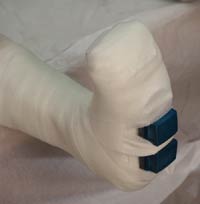New Study, Same Conclusion. It is time to take another look at Total Contact Casting

Total Contact Cast
The most recent and perhaps the most conclusive study of for treatment of the diabetic foot is a collaboration of three prominent organizations, The Society for Vascular Surgery, the American Podiatric Medical Association and the Society for Vascular Medicine. The guidelines, “The Management of the Diabetic Foot,” were developed after three years of studies and are published online and in print in the Journal for Vascular Surgery. Dr. Anil P. Hingorani is the lead author that researched and wrote the guidelines. With diabetes a major worldwide problem and little data on treatments, the need for detailed, diabetic foot clinical guidelines from multiple disciplines was great, said Hingorani.
The committee synthesized the points of view of the three different medical professions by researching one another’s treatment protocols. Vascular surgeons and vascular medicine specialists read literature from podiatry and vice versa, for example, and all participants concentrated on infectious disease control and guidelines, a large component of the finished document. Collaboration was key, Hingorani said. “We had multiple disciplines looking at the problem to bring the best information from each field to develop the guidelines,” he said, though only limited “high-quality evidence” was available for many of the critical questions.
One of the findings that physicians may find surprising, it was the importance of the total contact cast in the treatment of plantar diabetic foot ulcers, which the committee found was is supported by robust data. Off-loading takes all direct pressure off the ulcer through use of a total contact cast. “total contact casting is so under-utilized,” Hingorani said. “I think some surgeons may find it surprising and it may raise a few eyebrows. Many surgeons are not aware of how strong the evidence is for total contact casting. It is not new but not widely understood or implemented.”
read more